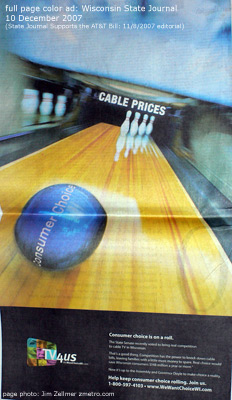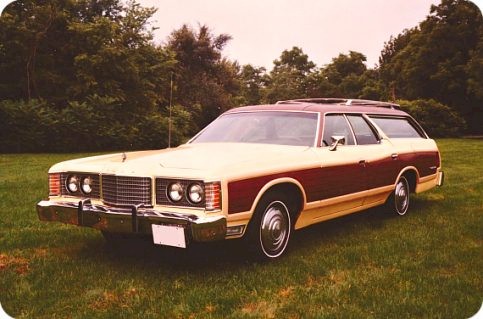Vincent Virga’s Cartographia is a rare collection of 250 color maps and illustrations drawn from the world’s largest cartographic collection at the Library of Congress. The collection spans everything from maps of ancient Mesopotamia, to maps of Columbus’ discoveries, to contemporary satellite images and maps of the human genome.
Virga says that maps are like time machines — they reveal as much about the society that created them as they do about the geography of the places they describe.
Virga discusses the collection, which he culled from the Library of Congress’ millions of maps and tens of thousands of atlases.
Madison Winter Storm Residue

Finding the Right Digital Photo Frame
As digital cameras proliferate, consumers want to make use of all of those pictures they’re taking. Many of them wind up buried on computer hard drives. But it’s getting easier to take those photos and display them on a digital photo frame in the living room.
These photo frames look just like any other picture frame from a distance. But they are, in fact, small liquid crystal displays that can change the photos on display every few seconds. For romantics and technology Luddites, that is a kind of blasphemy, a reflection of a fickle age where not even a still image can remain constant.
But who says you have to look at the same pictures of your relatives on the mantel for all eternity? Sometimes, change is good. That’s why digital photo frames were the No. 2 consumer technology gift on Black Friday, just behind navigation devices, according to market researcher NPD Group. Sales were up 171 percent compared with a year ago.
Picking a good digital photo frame is a matter of looking at the display and checking out its quality. If it looks good, that’s a clue.
Rolling Over for AT&T: “Video Competition” Bill is a Major Missed Opportunity for Wisconsin
A reader forwarded this full page, color advertisement paid for by large telco (AT&T, etc.) front group TV4us. The advertisement appeared in this morning’s Wisconsin State Journal. The State Journal supports the AT&T “video competition bill”. 
Click to view a larger version
Brian Clark has more:
Vergin said he’s pleased he’ll only have to get one state franchise, instead of having to deal with the 33 different municipalities in his service area.
“That’s a big benefit for us and what I think the bill is all about,” he said.
Vergin said his company’s prices won’t be any lower than Charter’s. But he’s convinced his firm will be able to offer better service and options to bundle cable, phone and wireless service.
He said he was opposed to proposed rules that would have required his company to serve entire communities. He also rejected suggestions telecommunications firms should be ordered to run fiber optic to homes and businesses.
“The 100 requirement would limit us,” he said. “And we are running fiber optic to new construction, but not existing buildings. I just don’t think the government should tell us what technology we should use. The market should decide that. I also think have 50 percent of any area covered is better than none.”
…..
(Charles) Higley (Citizen’s Utility Board Executive Director) said he, too, would have liked to have seen a requirement that companies build fiber optic cable.
“We’ve had promises to build it before and it didn’t come,” he said. “In the future, if not already, broadband is an essential service like telephone and electricity. We think government should require essential services.”
The Governor and Legislature appear to have obtained nothing while giving away significant regulatory changes. A disaster for Wisconsin business, schools residents and public agencies. What a deal for the large telcos: spend money on lobbying and advertising but not fiber to the home. Classic rentier approach: milk the slow copper network that we’ve paid for many times over as long as possible.
Keep in mind Verizon’s FIOS, a fiber to the home product installed in many communities [Service Map] – none in Wisconsin.
I recently had the opportunity to use basic FIOS service while on travel. The service was symmetrical – that is, upload and download speeds are the same. Local dsl services are not symmetrical – AT&T and TDS limit upload speeds to a very slow 768kpbs.
This archaic approach is awful for those of us creating, uploading and backing up media (photos, videos and music, not to mention data heavy scientific applications). FIOS provides at least 5 to 50X the speeds of the fastest dsl service generally available in the Madison area. Slow networks limit entrepreneurial opportunities, particularly emerging home based businesses.
Finally, I spoke briefly some years ago with then Gubernatorial candidate Jim Doyle at a campaign event. I mentioned Wisconsin’s very poor broadband infrastructure. He said he understood these issues but could not address them in his first term but hoped to in a second. Will Doyle leave a legacy of aging, slow copper networks? I put a call into Susan Goodwin, Chief of Staff, for an update.
——-
A bit of sugar for AT&T. This giant organization is fully capable of implementing a modern, high quality, fast fiber network. They simply need to make the strategic decision, as Verizon has, to upgrade their network. How much longer must we pay for the old, old copper lines? I’ve received excellent, economical service from AT&T’s cell network.
Background:
Requiem for a Station Wagon

One of the rare examples of altruism in pistonheads concerns the (nearly extinct) American station wagon. They passionately defend the one automotive genre that the vast majority of American consumers wouldn’t be caught dead in (excepting a hearse). Why so much love for a car shape that’s been fading from the American scene for the best part of 25 years? The passion comes from recognition. The reality we’ll have to blame on Darwin and his stupid birds.
Wagons increase a car’s cargo space without altering the donor car’s fundament shape. They’re a bit heavier and generally a little shakier than their sedan sibling, but still offer car-like driving dynamics. This is important to enthusiasts, who value driving dynamics sur tout. Ironically, pistonheads hate compromises; generally speaking, they don’t buy wagons. But they recommend them to others– especially SUV owners– based on the combination of handling and hauling.
Mayor Dave’s 2007 Property Tax Letter

Madison Mayor Dave Cieslewicz:[72K PDF]
Enclosed you will find your 2007 property tax bill. While the City of Madison processes your taxes, the property tax bill is actually made up of five parts. The Madison Metropolitan School District has the largest share, followed by the City, Dane County, and Madison Area Technical College. A small amount is also levied for the state forestry tax.
The primary concern in our community today is the quality of life and safety in our neighborhoods. This summer and fall, I attended eight listening sessions across the City on these issues. People told me they wanted their City government to make sure their neighborhoods are safe and healthy. In response, the City budget makes the following investments:
- Increasing Police Resources. In addition to 30 new officers, the City budget includes two additional crime analysts to make sure we’ re not j ust stronger, but also smarter, in use of our resources.
- Targeting Bad Landlords. The addition of three new building inspectors and our new nuisance abat ement ordinance give us the tools we need to get after landlords who don’t maintain their properties or adequatel y screen their tenants.
- Strengthening Neighborhoods. We doubled the Emerging Nei ghborhoods Fund to $200,000, giving us quick-access resources to prevent small problems from becoming bigger, more expensi ve ones. We’ re launching a Neighborhood Indicators Project to give us statistical early warning signs of neighborhood decline. The budget also funds another graffiti elimination crew to keep our neighborhoods free of gang-related messages.
- Programs for Young People. We are increasing Communi ty Service programs by over 7%, funding initiatives for after school and youth programs, and doubling the number of youth conservation corps crews.
The City budget also includes park improvements, expanded library hours at some branches, road
projects, energy efficiency initiatives, a new effort to clean our beaches, and other programs to maintain and improve Madi son’ s quality of life.
These words are a useful look at the Mayor’s perspective on local taxpayers.
If robotics technology now stands where computing did in the ’70s, what can we expect in the future?
Fremont resident Rakesh Guliani likes to say that a Roomba robotic vacuum cleaner saved his marriage.
Messy floors had been causing friction, says the 41-year-old Guliani (pronounced Goo-liani). His wife, Kavita, 35, was particularly annoyed by the footprints he and their daughters, Ashna, 10, and Rhea, 6, tended to track through the house.
“I am soccer coach to both of them, and when we come in with our dirty cleats, I am more tolerant of that because I am tracking dirt, too,” says Guliani, vice president of the job-placement firm Park Computer Systems. He vacuumed several times a week but it never seemed enough to satisfy his wife, a technical writer for Google.
“I was sucking the thread out of the carpet,” says Guliani, who bought a Roomba last fall and programmed it to scour the carpets for dust, dirt and grime. Regular cleanings by the Roomba restored household harmony. “It never gets bored and it never complains,” he says.
The Guliani family is at the cutting edge of what may be the next technological revolution – the emergence of software and hardware capable of performing tasks once reserved for that race of toolmakers called Homo sapiens.
“Sometime in the next 30, 40, 50 years we will have human-level machine intelligence,” predicts Marshall Brain, a computer science teacher turned author and technology forecaster.
Olin Park / Monona Terrace Winter Sunrise

A cold view (wind chill was below 0) from Olin Park early Saturday morning. Madison’s Monona Terrace and the State Capitol are visible.
Everyone’s Poop
“Down the drain, off the brain” is how most people think about it, but human waste—or effluent, as the professionals call it—has a lot to tell us about how we live, what we eat, and who we are.
They say that shit runs downhill. This is commonly understood to mean that the world is an unfair place, except among those few people who actually work with the substance, for whom it is considered something of an article of faith. This is because municipal sewerage systems are powered almost entirely by gravity, which means that when working properly, they move millions of gallons of sewage a day across considerable distances with only a minimum expenditure of energy, a feat of efficiency virtually unparalleled in the annals of engineering. When sewage stops running downhill, as it inevitably does from time to time, very bad things indeed can happen, as they did on Pecan Springs Road, in the Austin neighborhood known as Windsor Park, one morning last September.
I was spending the day with an Austin Water Utility emergency-response crew when dispatch got a call from a woman reporting that two rooms of her house were flooded with sewage. Our crew consisted of a TV truck, piloted by a twenty-year line-maintenance veteran named David Eller, and a flusher truck, driven by another longtime utility employee, named Dale Crocker. At the house, Eller, who wears wraparound sunglasses and looks a little like the country singer Dwight Yoakam, unspooled a thick red cable from the back of his truck. On the end of the cable was a camera about the size of a roll of quarters, which Crocker shoved down into a PVC clean-out pipe near the curb in the front yard. The woman leaned on a walker in her driveway, looking worried.
Excellent Article.
Monona Terrace Winter Sunrise

The journey to this morning’s Winter Farmer’s Market was beautiful, but quite cold. Madison’s Frank Lloyd Wright inspired Monona Terrace never fails to provide an interesting vantage point for the photographer.